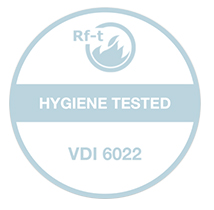Blog
Download our brochure

Stay informed
By Rf-Technologies
More than anywhere else, ventilation and air conditioning systems in hospitals and other highly sensitive areas of health care, need to meet critical hygiene and safety requirements. Since every component in the HVAC system needs to comply to these stringent requirements, Rf-Technologies has tested and certified their products to carry a ‘Hygiene Tested’ label
All Rf-t products are safe and hygienic by design, independent of the area of application. However, in some environments stricter requirements and hygienic regulations apply for any installed equipment. In hospitals, and particularly in operating rooms, intensive care units, maternity or neonatal units, cleanrooms and labs, room air contamination must be avoided at all times. Dust, airborne bacterial contaminants, waste anaesthetic gases and odorous substances need to be contained, kept to a minimum level and removed by an effective and reliable air conditioning system

But also any other environment where airborne particles can have serious consequences or affect the quality of the manufactured products, such as pharmaceutical-, food-, semiconductor-, and aerospace production facilities, have similar hygienic requirements. Ventilation and air conditioning systems in these buildings need to comply with official hygiene requirements ensuring that no dangerous, hazardous, or risky substances are released to the surrounding environment. When Installed in these ventilation systems, our fire dampers have to meet the same demanding requirements of hygiene and safety.
Our CU2, CU-LT, CR60 and CR120 (rectangular and round) fire dampers carrying a Hygiene Tested label, meet these critical air cleanliness and very critical hygiene requirements. The manufacturing process, materials, constructional and operational design, do not affect Health by any means.
Hygiene standards and certifications
Our Hygiene Tested fire dampers comply with the official hygiene requirements specified by the applicable ventilation and air conditioning standards and regulation .
One of the most established and globally accepted hygienic air handling unit certifications and is the Eurovent Certified Performance for Hygienic Air Handling Units. This certification is generally appreciated, and is a common reference for engineers, planners, and installers. For some countries there are (additional) local hygienic guideline. In Germany, for instance, they follow the VDI 6022-1 for general ventilation and lower healthcare applications or the DIN 1946-4 codes. Additional local standards include, among others, the HTM 03-01 for the UK, the PZH Atest Higieniczny for Poland and the SWKI VA 104-01 (similar to VDI) for Switzerland.
Other relevant standards and norms are:
- EN 779 Particulate air filters for general ventilation (filtration efficiency)
- EN 1822 (all parts) Particulate filters (HEPA and ULPA)
- EN 13779 Ventilation for non-residential buildings – Performance requirements for ventilation and room-conditioning systems
- ISO 14644-3 Clean rooms and related clean room areas – test method
- DIN 1946-4 Ventilation and air conditioning in health car
- SWKI Guideline 99-3 Heating and air conditioning systems in hospital buildings
- NSI/ASHRAE Standard 170 Ventilation of health care facilities European standar
- EN 13779 (09/2007) Air Handling – Performance requirements for ventilation and room-conditioning system
- Austrian standards ÖNORM H 6021 (09/2003) – ÖNORM H 6020 (02/2007)
